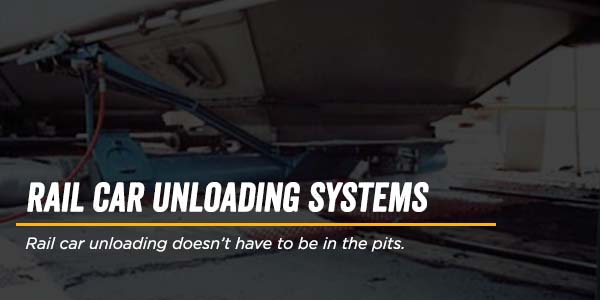
Rail cars offer a cost effective alternative in receiving dry bulk materials for companies with available rail side unloading points and high consumption of a raw material or materials. Rail cars typically can hold volumes of 3,500 to 5,500 cubic feet and can transport up to 120 tons of raw material at a time.
Evaluating cost effective alternatives for material unloading systems is critical when considering the best way to receive shipments. The demurrage costs of holding a rail car can become quite high in some cases, so rapid unloading may be desired. This must be balanced against the high operating costs of excessively large blower packages when pneumatically unloading and/or the high cost of ongoing maintenance and material exposure from open pit mechanical systems.
There are various types of rail cars on the market today, each with differing ways to unload them. The most common of these cars in the dry bulk handling industry is the covered hopper bottom car. These cars have internal compartments that slope to discharge gates that allow material to be discharged from the bottom of the car. Various car designs exist from different rail car manufacturer’s and have anywhere from 2 to 5 hoppers with discharge gates ranging from 18” x 42” to 24” x 30” and beyond, including round “Cabot” cars. These cars can are typically unloaded in one of two ways: dumping them into a pit, or attaching a pan and vacuuming the material out via a pneumatic conveying system.
Unloading these cars by means of an open pit is the fastest way to empty the car. The operator simply positions the car over a dumping point and opens the rail car hopper(s) to an underground hopper below. For dusty powders, a boot lift connection may be engaged to help contain fugitive dusts during this time. The use of a boot lift may also require a rail car “puller” that can move the car along the rails to position the next compartment over the discharge point.
While fast, this method has its drawbacks. Rail car pits are often exposed to the outdoor elements and can collect rain and snow in them. Also, because they exist under the tracks, digging them out and then reinforcing and supporting the tracks above the pit can be quite expensive in terms of capital cost and installation. Once they are built, connections for screws, belts, rotary valves, etc can be quite cumbersome and difficult to perform maintenance on, since they are basically underground.
As an alternative to these pits, a Rail Car Discharge Adapter (RCDA) can be used to transition from the car’s hopper discharge gate to a vacuum pneumatic conveying line. This device can be inserted between the gate and grade. It serves as a transition to a pipe stub (4” to 8” line) with a hose fitting, allowing flexibility in positioning of the car by using a flexible hose connection to attach to a trackside pipe manifold where the material can be vacuumed out of the car to its destination or transitioned to a pressure conveying system where it can be sent on to farther distances and/or multiple destinations more efficiently. Each adapter also includes a bleed-air gate to allow for manual balancing of the material-to-air ratio of the conveying system at the pick-up point.
These adapters come in two basic types: a manual clamp style and a single operator sled style. In the clamp style usually two operators go out and manually clamp an ~175 pound RCDA to the discharge gate frame and then attach a hose to it. It is lower in cost to purchase, but more cumbersome to operate. In the sled style unit a single operator can take a unit on wheels that is retracted to a low profile (7” to 9”) and then raised up to form a dust tight connection when under the car. (Note: pneumatic cylinders are provided to allow the RCDA to rise wit the car as it losses weight from unloading and raises on its shocks). This type of unit is easier to operate, but does require a fairly even surface near the tracks to be pushed around on.
Whether you have an existing unloading system and just want a better way to connect to the railcar or are looking for a complete rail car unloading system, Magnum Systems can help you keep your line moving.
Additionally, If you have a PD Railcar check out our H-Valve Unloading System.
Related Post
Customized Nuisance Dust Collection and Control in Pneumatic Conveying Systems
11 Pneumatic System Considerations for the Chemical Industry
Choosing the Right Bulk Bag Filling Equipment in the Chemical Industry
Using Robotics to Overcome Manual Palletizing System Challenges